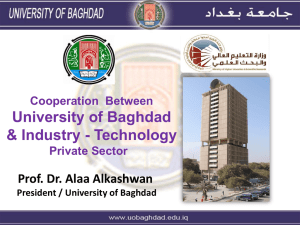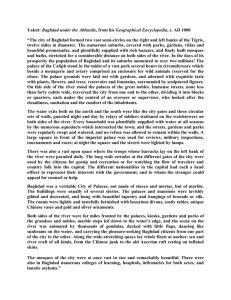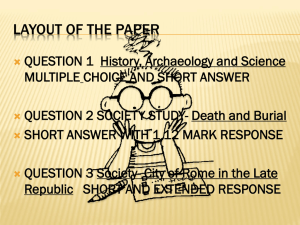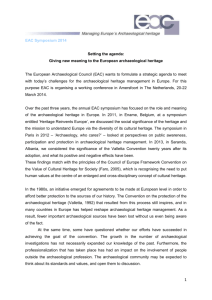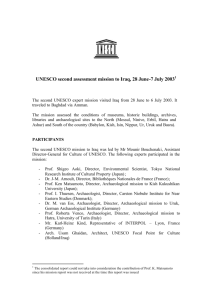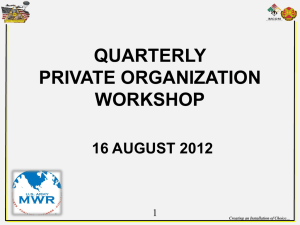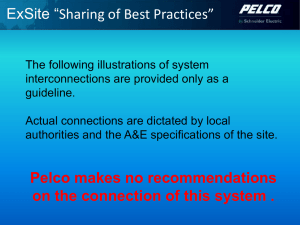presentation - Cultural Heritage by Archaeology and
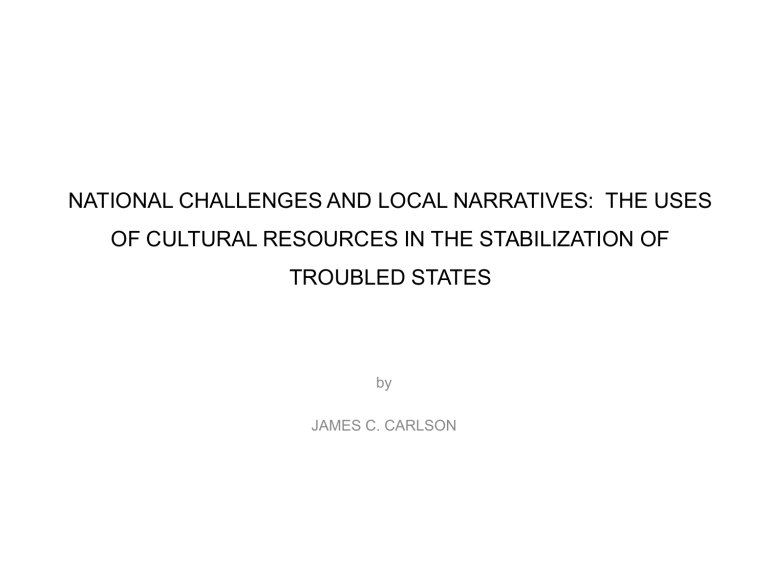
NATIONAL CHALLENGES AND LOCAL NARRATIVES: THE USES
OF CULTURAL RESOURCES IN THE STABILIZATION OF
TROUBLED STATES by
JAMES C. CARLSON
BLUF
It is through a shared cultural heritage that people both legitimize and consent to a shared agenda. In this way, heritage is an influential device in the construction of national states.
Agenda
• BLUF
• Archaeological site on a military installation near Baghdad
• Ctesiphon
• Nation Building
- identity, economy, and stability
• The Way Forward
• contextualization of interpretations of the past
(Dodd and Boytner 2010: 3)
• contextualization of interpretations of the past
(Dodd and Boytner 2010: 3)
• contextualization of interpretations of uses of the past
http://www.cemml.colostate.edu/cultural/09476/iraq01.html
Archaeological site on a military installation near Baghdad
Archaeological site on a military installation near Baghdad
Archaeological site on a military installation near Baghdad
Archaeological site on a military installation near Baghdad
Archaeological site on a military installation near Baghdad
Archaeological site on a military installation near Baghdad
1 hectare of ancient settlement:
• Old Babylonian period = 1800-1600 BC
• Kassite Period = 1500-1150 BC
• Seleucid Dynasty = 305-64 BC
• Parthian-Sassanian periods = 538 BC - AD 641
• Abbasid period = 750-1258 AD
Archaeological site on a military installation near Baghdad
Archaeological site on a military installation near Baghdad
Archaeological site on a military installation near Baghdad
Archaeological site on a military installation near Baghdad
Archaeological site on a military installation near Baghdad
Ctesiphon
Taq-I Kisra: Ctesiphon
Arch
soccer field in park at
Ctesiphon
Taq-I Kisra:
1950
Iraq: Two Key Traits
• a diverse human population
• a rich cultural heritage
Pillars of National Unity
• state control
- infrastructure, governance, laws, security etc.
• a core identity and interests
• shared ethnicity
Pillars of National Unity:
Iraq
• state control
- infrastructure, governance, laws, security etc.
• a core identity and interests
• shared ethnicity
Cultural narratives “are constituted through representation and performance, conveying not only who we are but also who we will come to be.”
Somers (1994)
C ultural heritage “provides a rather effective material and symbolic support” for a society’s narratives.
Anico and Peralta (2009)
Summary
1.
economic diversity = economic sustainability
2.
unity through a shared cultural heritage
3. cultural resources = a stability "engine"
The Way Forward incorporate cultural resources into:
• PMESSI
(Political, Military, Economic, Social, Infrastructure and Information systems)
• ASCOPE
(Area, Structures, Capabilities, Organizations, People and Events)
• SWEATMS
(sewage, water, electricity, academics, trash, medical and security)
+ cultural resources = SWEATMS-C
The Way Forward assess:
• views of local populations
• past and present uses of cultural resources
The Way Forward benefits to US/USF efforts:
1. mitigation of threats, social frictions, and/or conflicts regarding cultural resources
2. enabling of the handling of dialogue, messaging, and public relations
3. avoiding potential negative legal and publicity issues
Acknowledgments:
Special thanks to:
Laurie Rush
Diane Siebrandt
Jen Clark
COL Bartholf
QUESTIONS?
